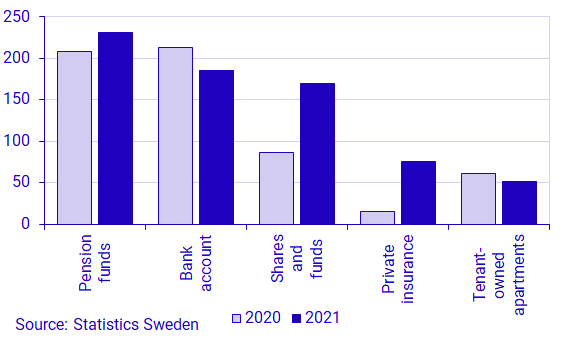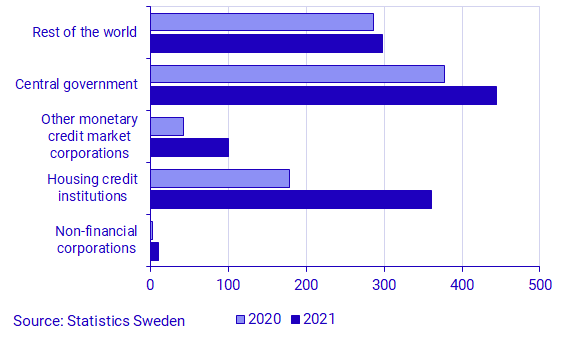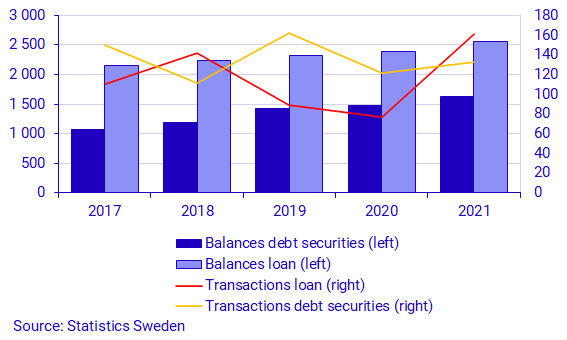Financial Accounts fourth quarter 2021
High levels of household savings in 2021
Statistical news from Statistics Sweden and Swedish Financial Supervisory Authority 2022-03-17 8.00
Households´ financial savings amounted to SEK 81 billion in the fourth quarter of 2021, which is in line with the corresponding quarters the two previous years. The Riksbank continued to purchase bonds during 2021 and central government debt rose mainly as a result of the weakening of the Swedish krona.
Household savings remained high in 2021
In the fourth quarter of 2021, households’ net savings in financial assets were SEK 175 billion, while liabilities increased by SEK 94 billion, which led to financial savings of SEK 81 billion.
During the full year 2021, households’ net savings in financial assets amounted SEK 734 billion, which was SEK 99 billion higher than in 2020. Households had net savings of SEK 232 billion in pension funds reserves, which include occupational pensions and premium pensions. Net savings in bank accounts and shares and funds were also high during the year. The private insurance savings were at a record level compared to previous years and amounted SEK 75 billion.

During the full year 2021, the households’ debt increased by SEK 333 billion and amounted to SEK 5 219 billion at the end of the year. The households’ debt largely consists of loans, which at the end of 2021 had an annual growth rate of 6.8 percent.
The Riksbank bond holdings increased
In the fourth quarter of 2021, the Riksbank continued to purchase bonds aimed at keeping interest rates in general at a low level and contributing to an efficient supply of credit. The Riksbank’s holdings in bonds amounted to SEK 1 277 billion at the end of 2021, which is SEK 346 billion more than in 2020.
In 2021, the Riksbank made net purchases of bonds issued by monetary financial institutions, largely mortgage bonds, of SEK 187 billion. Holdings of corporate bonds amounted to SEK 10 billion at the end of 2021. The Riksbank also continued to purchase government bonds, and holdings amounted to SEK 445 billion at the end of the year. Holdings of foreign bonds increased by SEK 11 billion in 2021.

Non-financial corporations’ financing
In the fourth quarter of 2021, non-financial corporations made net emissions of debt securities, that is, new emissions minus maturity, amounting to SEK 46 billion. In the full year 2021, net emissions were positive and amounted to SEK 133 billion. Non-financial corporations borrowed SEK 158 billion during the full year 2021 from banks and other monetary financial institutions.

New emissions of listed shares were also a common form of financing for non-financial corporations in 2021. New emissions minus repurchase amounted to SEK 78 billion in the fourth quarter and SEK 219 billion in the full year 2021.
Central Government debt increased in 2021
In the end of 2021, the market valued central government debt amounted to SEK 2 325 billion, which was an increase of SEK 38 billion during the year. This can be compared with 2020 when the central government debt increased by SEK 263 billion. In 2021 the weakening of the Swedish krona was the main reason to the larger central government debt, as a part of central government issued debt securities were denominated in foreign currency. In 2021 the central government continued the support measures which led to a negative financial savings amounting to minus SEK 62 billion.
Revisions
In conjunction with the production of the fourth quarter 2021, yearly and quarterly statistics have been revised for the period 2018-2021Q3. Holdings in debt securities and holdings in foreign shares and funds have been revised as from the first quarter 2019 with data from securities holdings statistics (VINN). This may lead to a break in the time series between the fourth quarter of 2018 and the first quarter of 2019. Further information on the introduction of VINN is available under “More information” on the Financial Accounts product page. Furthermore, the Rest of the World sector was revised as from the first quarter of 2018 with new information from the Balance of Payments. For public administration, revisions were made from 2019 primarily related to updated taxes.
Definitions and explanations
The financial accounts aim to provide information about financial assets and liabilities, and about changes in financial savings and financial wealth in different economic sectors.
Financial savings, net lending/net borrowing, in the Financial Accounts is calculated as the difference between transactions in financial assets and transactions in liabilities. Net lending/net borrowing is measured as the difference between income and costs in the non-financial sector accounts, which, like the Financial Accounts, form part of the National Accounts. However, the financial accounts and non-financial sector accounts are based on different sources, which gives rise to differences.
In the Financial Accounts, the national debt calculation is different from the measure of national debt most often reported, which is calculated based on the convergence criteria, also known as the Maastricht debt. The Maastricht debt does not comprise all financial instruments; the instruments are reported at nominal value, and the central government debt is consolidated. In the Financial accounts, the national debt is unconsolidated and includes all financial instruments at market value.
In addition to government agencies, the central government sector also includes certain government foundations and some State-owned enterprises. Central government does not include units in the old-age pension system. Instead, they comprise of the sector social security funds. Local government includes primary municipal authorities, regional authorities (formerly county council authorities), municipal associations, some municipal foundations, and some local government-owned enterprises.
Further information: The National Wealth
The National Wealth, which contains annual data on non-financial and financial assets, is also published in connection with the publication of the Financial Accounts. Financial assets and liabilities are collected from Financial Accounts and are thereby consistent with the values published in Financial Accounts.
For further information, see:
Nationalförmögenheten och nationella balansräkningar (in Swedish) (pdf)
Next publishing will be
The next statistical news item in this series is scheduled for publication on 2022-06-16 at 08:00.
Statistical Database
More information is available in the Statistical Database
Feel free to use the facts from this statistical news but remember to state Source: Statistics Sweden.
